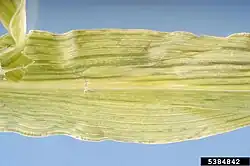Sugarcane mosaic virus
Description
Sugarcane mosaic virus (SCMV) is a plant pathogenic virus that primarily infects members of the grass family (Poaceae), including sugarcane, maize, sorghum, and other cereal crops. It causes mosaic-like symptoms on leaves, including yellow streaks, mottling, and stunted growth, which lead to significant yield loss in infected crops.
Transmission
The virus is mainly transmitted by aphids in a non-persistent manner. It can also be spread mechanically through farming tools or vegetative propagation in crops like sugarcane.
Distribution
SCMV is widespread and has been reported in Asia, Africa, the Americas, and Europe. It thrives particularly in tropical and subtropical regions where sugarcane and maize are commonly cultivated.
Importance
SCMV is of economic concern in agriculture due to its impact on staple food and cash crops. Management strategies include using resistant varieties, crop rotation, and controlling insect vectors.
Gallery

Taxonavigation
Classification System: ICTV (2023 Release, MSL#39, release v3)
(Unranked): Virus
Group IV: ssRNA(+)
Ordo: -
Familia: Potyviridae
Genus: Potyvirus
Species: Sugarcane mosaic virus
Name
Sugarcane mosaic virus
References
- ICTV Virus Taxonomy 2014
- Hall, J.S., et al. (1998). Molecular analysis of the coat protein of Sugarcane mosaic virus. Archives of Virology, 143(3), 403–416.
- Singh, R.P., & Raut, R.S. (1993). Sugarcane mosaic virus: A major pathogen of sugarcane. Indian Phytopathology, 46(1), 1–12.
- ICTV (International Committee on Taxonomy of Viruses).